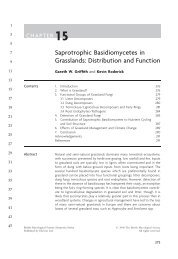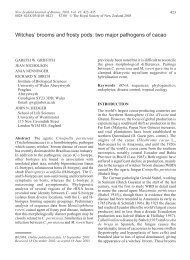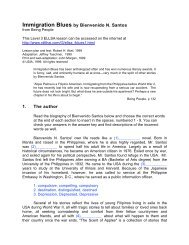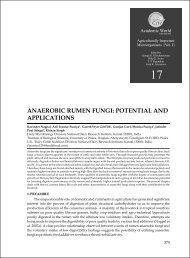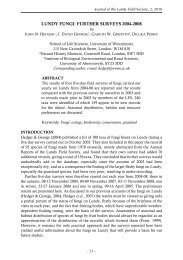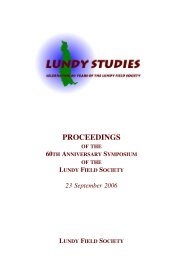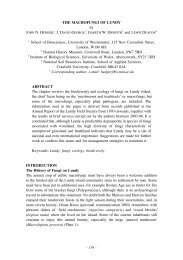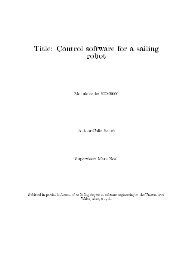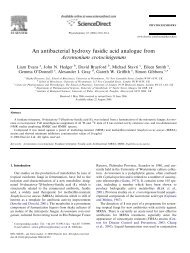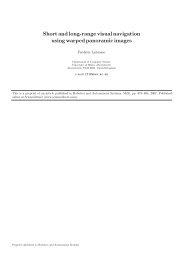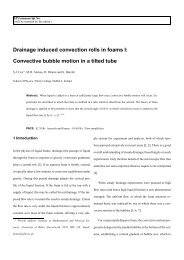Chytridiomycota - Users Site
Chytridiomycota - Users Site
Chytridiomycota - Users Site
Create successful ePaper yourself
Turn your PDF publications into a flip-book with our unique Google optimized e-Paper software.
Spizellomycetales, is an open question because of<br />
limited sampling of taxa, a paucity of molecular data<br />
and phylogenetic uncertainty (in the case of O.<br />
brassicae).<br />
Molecular studies have revealed that many currently<br />
defined genera in Chytridiales are polyphyletic<br />
(James et al 2000, Letcher and Powell 2005b, Letcher<br />
et al 2005). Our results show that neither developmental<br />
characters, such as polycentric growth, or<br />
sporangial characters, such as presence of an operculum,<br />
will be useful in defining families or even<br />
genera. These phylogenies demonstrate a repeated<br />
evolution of polycentric growth in nearly every well<br />
sampled clade, suggesting the evolution of this form<br />
of indeterminant growth does not require a complex<br />
genetic change. Some of the largest genera (e.g.<br />
Rhizophydium, Entophlyctis and Chytriomyces) are<br />
based on few distinctive characters and are dramatically<br />
in need of revision. Other genera are highly<br />
distinctive (e.g. Loborhiza, Obelidium) but are monotypic.<br />
Current efforts are focused on combining<br />
morphological, ultrastructural and molecular data to<br />
use a holistic approach for redefining genera of<br />
Chytridiales (e.g. Letcher and Powell 2005b).<br />
Application of zoospore ultrastructural characters.—A<br />
resolved phylogeny of the chytrid fungi now permits<br />
the mapping of ultrastructural character states onto<br />
the gene tree to further our understanding of<br />
character evolution. For example the electron-dense<br />
plug in the base of the flagellum has been<br />
considered phylogenetically informative (Barr<br />
2001). This structural character state is present in<br />
all members of the Chytriomyces (2K, Letcher et al<br />
2005), Cladochytrium (2D) and Polychytrium (2C)<br />
clades examined thus far. It is absent in the Rozella<br />
(1), Neocallimastigales (2A), Blastocladiomycota (3)<br />
and Olpidium (4) clades (Barr 2001). When the<br />
presence or absence of this character is mapped<br />
onto the rDNA phylogeny, it appears that this<br />
character was present in the ancestor of the<br />
Chytridiales and Monoblepharidales (clades 2B–K)<br />
but has been lost repeatedly in independent<br />
lineages (FIG. 2). For example in the Synchytrium<br />
clade (2E) this structure may be either present (S.<br />
endobioticum, Lange and Olsen 1978) or absent (S.<br />
macrosporum, Montecillo et al 1980); in the Monoblepharidales<br />
(2B) it is either present (i.e. Monoblepharis<br />
polymorpha, Mollicone and Longcore 1994)<br />
or lost (Gonapodya polymorpha, Mollicone and Longcore<br />
1999); it has been lost in the Spizellomycetales<br />
(2I and 2J, Barr 1980) and Rhizophydium clades (2G;<br />
Letcher et al 2004b, 2006). Thus an apparently<br />
identical character state, the absence of the flagellar<br />
plug, is a convergent character state if applied to<br />
Mycologia myco-98-06-18.3d 4/1/07 13:38:53 869 Cust # 06-083R<br />
JAMES ET AL: PHYLOGENY OF CHYTRID FUNGI 869<br />
organisms from different lineages but it may be<br />
a valuable character for taxonomic purposes within<br />
a lineage. The heuristic exercise of mapping<br />
morphological characters on gene trees suggests<br />
that some character states have evolved repeatedly in<br />
distinct lineages, thus creating an opportunity for<br />
previous assumptions regarding character homology<br />
to be reassessed in a phylogenetic context.<br />
Summary of current phylogenetic knowledge and<br />
remaining questions.—We have identified four major<br />
lineages of chytrid fungi, the largest of which can be<br />
subdivided into 11 additional clades. By increasing<br />
the sampling of both rRNA characters and species we<br />
have greatly expanded our knowledge of phylogenetic<br />
diversity and relationships among the groups of<br />
chytrids. Our results confirm previous phylogenetic<br />
studies and ultrastructural information that suggest<br />
the Blastocladiales is distinct from the remaining<br />
chytrids and possibly more closely related to the<br />
nonzoosporic fungi than the core chytrids. Thus we<br />
have elevated the order Blastocladiales to the level of<br />
phylum (Blastocladiomycota). Based on the present<br />
research, as well as the results of the Assembling the<br />
Fungal Tree of Life project (http://ocid.nacse.org/<br />
research/aftol/) and complete sequencing of fungal<br />
mitochondrial genomes (Seif et al 2005), the phylogeny<br />
of the core chytrids is beginning to be resolved<br />
with the Neocallimastigales as the earliest diverging<br />
lineage and the Monoblepharidales as sister taxon of<br />
a clade containing Chytridiales+Spizellomycetales.<br />
Phylogenetic investigations in the past three years<br />
suggest that much of the diversity in the chytrids is<br />
found in species that are not readily cultured (e.g.<br />
Olpidium, Rozella, Synchytrium). Remaining questions<br />
in the chytrid phylogeny are the exact placement of<br />
Olpidium and whether microsporidia are a part of the<br />
basal grade of chytrids. Further sampling of DNA<br />
sequences from species that are obligate biotrophic<br />
parasites with unique zoospore ultrastructure (e.g.<br />
Caulochytrium [Powell 1981], Thalassochytrium [Nyvall<br />
et al 1999] and Zygorhizidium [Beakes et al 1988])<br />
might yet uncover additional clades. Furthermore,<br />
given that a number of chytrid species are facultative<br />
or obligate anaerobes, sampling of these environments<br />
also might uncover additional phylogenetic<br />
diversity.<br />
ACKNOWLEDGMENTS<br />
We thank Alison Mao for diligent technical assistance with<br />
DNA sequencing. Material in the form of cultures and<br />
herbarium material used for these studies was kindly<br />
provided by Robert Campbell, John W. Taylor and Howard<br />
Whisler. We thank Will Blackwell for nomenclatural<br />
assistance and Gary Easton, Marilyn R.N. Mollicone and



